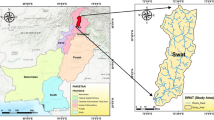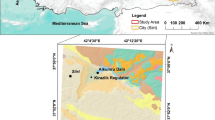Abstract
The main objective of this study was to apply a statistical (information value) model using geographic information system (GIS) to the Chencang District of Baoji, China. Landslide locations within the study area were identified using reports and aerial photographs, and a field survey. A total of 120 landslides were mapped, of which 84 (70 %) were randomly selected for building the landslide susceptibility model. The remaining 36 (30 %) were used for model validation. We considered a total of 10 potential factors that predispose an area to a landslide for the landslide susceptibility mapping. These included slope degree, altitude, slope aspect, plan curvature, geomorphology, distance from faults, lithology, land use, mean annual rainfall, and peak ground acceleration. Following an analysis of these factors, a landslide susceptibility map was produced using the information value model with GIS. The resulting landslide susceptibility index was divided into five classes (very high, high, moderate, low, and very low) using the natural breaks method. The corresponding distribution area percentages were 29.22, 25.14, 15.66, 15.60, and 14.38 %, respectively. Finally, landslide locations were used to validate the results of the landslide susceptibility map using areas under the curve (AUC). The AUC plot showed that the susceptibility map had a success rate of 81.79 % and a prediction accuracy of 82.95 %. Based on the results of the AUC evaluation, the landslide susceptibility map produced using the information value model exhibited good performance.













Similar content being viewed by others
References
Akgun A (2012) A comparison of landslide susceptibility maps produced by logistic regression, multi-criteria decision, and likelihood ratio methods: a case study at İzmir, Turkey. Landslides 9:93–106
Akgun A, Dag S, Bulut F (2008) Landslide susceptibility mapping for a landslide-prone area (Findikli, NE of Turkey) by likelihood frequency ratio and weighted linear combination models. Environ Geol 54(6):1127–1143
Ayalew L, Yamagishi H (2005) The application of GIS-based logistic regression for landslide susceptibility mapping in the Kakuda Yahiko Mountains, Central Japan. Geomorphology 65:15–31
Bai S, Lu G, Wang J, Zhou P, Ding L (2010) GIS-based rare events logistic regression for landslide-susceptibility mapping of Lianyungang, China. Environ Earth Sci 62(1):139–149
Bui DT, Pradhan B, Lofman O, Revhaug I, Dick OB (2012a) Landslide susceptibility assessment in the Hoa Binh Province of Vietnam: a comparison of the Levenberg–Marquardt and Bayesian regularized neural networks. Geomorphology 171–172:12–29
Bui DT, Pradhan B, Lofman O, Revhaug I, Dick OB (2012b) Spatial prediction of landslide hazards in Hoa Binh province (Vietnam): a comparative assessment of the efficacy of evidential belief functions and fuzzy logic models. Catena 96:28–40
Can T, Nefeslioglu HA, Gokceoglu C, Snomez H, Duman TY (2005) Susceptibility assessment of shallow earth flows triggered by heavy rainfall at three sub catchments by logistic regression analyses. Geomorphology 72:250–271
Choi J, Oh HJ, Lee HJ, Lee CW, Lee S (2012) Combining landslide susceptibility maps obtained from frequency ratio, logistic regression, and artificial neural network models using ASTER images and GIS. Eng Geol 124:12–23
Devkota KC, Regmi AD, Pourghasemi HR, Yoshida K, Pradhan B, Ryu IC, Dhital MR, Althuwaynee OF (2013) Landslide susceptibility mapping using certainty factor, index of entropy and logistic regression models in GIS and their comparison at Mugling–Narayanghat road section in Nepal Himalaya. Nat Hazards 65:135–165
Dieu Tien B, Owe L, Inge R, Oystein D (2011) Landslide susceptibility analysis in the Hoa Binh province of Vietnam using statistical index and logistic regression. Nat Hazards 59:1413–1444
Duman TY, Can T, Gokceoglu C, Nefeslioglu HA, Sonmez H (2006) Application of logistic regression for landslide susceptibility zoning of Cekmece Area, Istanbul, Turkey. Env Geol 51:241–256
Felicisimo A, Cuartero A, Remondo J, Quiros E (2013) Mapping landslide susceptibility with logistic regression, multiple adaptive regression splines, classification and regression trees, and maximum entropy methods: a comparative study. Landslides 10:175–189
Garcia-Rodriguez MJ, Malpica JA, Benito B, Diaz M (2008) Susceptibility assessment of earthquake triggered landslides in El Salvador using logistic regression. Geomorphology 95:172–191
Gorsevski PV, Gessler PE, Foltz RB, Elliot WJ (2006) Spatial prediction of landslide hazard using logistic regression and ROC analysis. Trans GIS 10(3):395–415
HR Pourghasemi (2008) Landslide hazard assessment using fuzzy logic (Case Study: A part of Haraz Watershed), M.Sc. Thesis Tarbiat Modarres University International Campus Iran 92
Komac M (2006) A landslide susceptibility model using analytical hierarchy process method and multivariate statistics in perialpine-Slovenia. Geomorphology 74:17–28
Kundu S, Saha AK, Sharma DC, Pant CC (2013) Remote sensing and GIS based landslide susceptibility assessment using binary logistic regression model: a case study in the Ganeshganga Watershed, Himalayas. J Indian Soc Remote Sens 41(3):697–709
Lee S (2005) Application of logistic regression model and its validation for landslide susceptibility mapping using GIS and remote sensing data. Int J Remote Sens 26:1477–1491
Lee S, Pradhan B (2007) Landslide hazard mapping at Selangor, Malaysia using frequency ratio and logistic regression models. Landslides 4:33–41
Lee S, Sambath T (2006) Landslide susceptibility mapping in the Damrei Romel area, Cambodia using frequency ratio and logistic regression models. Environ Geol 50(6):847–855
Lee S, Choi J, Oh H (2009) Landslide susceptibility mapping using a neuro-fuzzy. Abstract presented at American Geophysical Union, Fall Meeting 2009, abstract #NH53A-1075
Mihaela C, Martin B, Marta CJ, Marius V (2011) Landslide susceptibility assessment using the bivariate statistical analysis and the index of entropy in the Sibiciu Basin (Romania). Environ Earth Sci 63:397–406
Nefeslioglu HA, Gokceoglu C, Sonmez H (2008) An assessment on the use of logistic regression and artificial neural networks with different sampling strategies for the preparation of landslide susceptibility maps. Eng Geol 97:171–191
Oh HJ, Pradhan B (2011) Application of a neuro-fuzzy model to landslide-susceptibility mapping for shallow landslides in a tropical hilly area. Comput Geosci 37(9):1264–1276
Ozdemir A, Altural T (2013) A comparative study of frequency ratio, weights of evidence and logistic regression methods for landslide susceptibility mapping: Sultan Mountains, SW Turkey. J Asian Earth Sci 64:180–197
Pourghasemi HR, Jirandeh AG, Pradhan B, Xu C, Gokceoglu C (2013a) Landslide susceptibility mapping using support vector machine and GIS at the Golestan Province, Iran. J Earth Syst Sci 122:349–369
Pourghasemi HR, Moradi HR, Fatemi Aghda SM (2013b) Landslide susceptibility mapping by binary logistic regression, analytical hierarchy process, and statistical index models and assessment of their performances. Nat Hazards 69:749–779
Pourghasemi HR, Pradhan B, Gokceoglu C, Deylami Moezzi K (2013c) A comparative assessment of prediction capabilities of Dempster-Shafer and weights-of-evidence models in landslide susceptibility mapping using GIS. Geomat. Geomat, Nat Hazards Risk 4(2):93–118
Pourghasemi HR, Pradhan B, Gokceoglu C, Mohammadi M, Moradi HR (2013d) Application of weights-of-evidence and certainty factor models and their comparison in landslide susceptibility mapping at Haraz watershed, Iran. Arab J Geosci 6:2351–2365
Pradhan B (2010) Application of an advanced fuzzy logic model for landslide susceptibility analysis. Int J Comput Intel Syst 3(3):370–381
Pradhan B (2011a) Manifestation of an advanced fuzzy logic model coupled with geoinformation techniques coupled with geoinformation techniques for landslide susceptibility analysis. Environ Ecol Stat 18(3):471–493
Pradhan B (2011b) Use of GIS-based fuzzy logic relations and its cross application to produce landslide susceptibility maps in three test areas in Malaysia. Environ Earth Sci 63(2):329–349
Pradhan B (2013) A comparative study on the predictive ability of the decision tree, support vector machine and neuro-fuzzy models in landslide susceptibility mapping using GIS. Comput Geosci 51:350–365
Pradhan B, Lee S (2010a) Delineation of landslide hazard areas on Penang Island, Malaysia, by using frequency ratio, logistic regression, and artificial neural network models. Environ Earth Sci 60(5):1037–1054
Pradhan B, Lee S (2010b) Landslide susceptibility assessment and factor effect analysis: back-propagation artificial neural networks and their comparison with frequency ratio and bivariate logistic regression modeling. Environ Model Softw 25(6):747–759
Pradhan B, Pirasteh S (2010) Comparison between prediction capabilities of neural network and fuzzy logic techniques for landslide susceptibility mapping. Disaster Adv 3(2):26–34
Pradhan B, Oh HJ, Buchroithner M (2010) Weights-of-evidence model applied to landslide susceptibility mapping in a tropical hilly area. Geomatics Nat Hazards Risk 1(3):199–223
Regmi AD, Devkota KC, Yoshida K, Pradhan B, Pourghasemi HR, Kumamoto T, Akgun A (2013) Application of frequency ratio, statistical index, and weights-of-evidence models and their comparison in landslide susceptibility mapping in Central Nepal Himalaya. Arab J Geosci 7(2):725–742
Saito H, Nakayama D, Matsuyama H (2009) Comparison of landslide susceptibility based on a decision-tree model and actual landslide occurrence: the Akaishi mountains, Japan. Geomorphology 109:108–121
Sezer EA, Pradhan B, Gokceoglu C (2011) Manifestation of an adaptive neuro-fuzzy model on landslide susceptibility mapping: Klang Valley, Malaysia. Exp Syst Appl 38:8208–8219
Solaimani K, Mousavi SZ, Kavian A (2013) Landslide susceptibility mapping based on frequency ratio and logistic regression models. Arab J Geosci 6:2557–2569
Vahidnia MH, Alesheikh AA, Alimohammadi A, Hosseinali F (2010) A GIS-based neuro-fuzzy procedure for integrating knowledge and data in landslide susceptibility mapping. Comput Geosci 36(9):1101–1114
Van Den Eeckhaut M, Vanwalleghem T, Poesen J, Govers G, Verstraeten G, Vandekerckhove L (2006) Prediction of landslide susceptibility using rare events logistic regression: a case-study in the Flemish Ardennes (Belgium). Geomorphology 76:392–410
Westen van CJ (1993) Application of geographical information system to landslide hazard zonation. ITC, International institute for aerospace and earth res. surv. ITC Publication. Enschede, The Nethelands
Wu XL, Niu RQ, Ren F, Peng L (2013) Landslide susceptibility mapping using rough sets and back-propagation neural networks in the Three Gorges, China. Environ Earth Sci 70:1307–1318
Xu C, Dai FC, Xu X, Lee YH (2012) GIS-based support vector machine modeling of earthquake-triggered landslide susceptibility in the Jianjiang River watershed, China. Geomorphology 145–146:70–80
Yalcin A (2008) GIS-based landslide susceptibility mapping using analytical hierarchy process and bivariate statistics in Anderson (Turkey): comparison of results and confirmations. Catena 1:1–12
Yalcin A, Reis S, Cagdasoglu A, Yomralioglu T (2011) A GIS-based comparative study of frequency ratio, analytical hierarchy process, bivariate statistics and logistics regression methods for landslide susceptibility mapping in Trabzon, NE Turkey. Catena 85:274–287
Yao X, Tham LG, Dai FC (2008) Landslide susceptibility mapping based on support vector machine: a case study on natural slopes of Hong Kong, China. Geomorphology 101:572–582
Yeon YK, Han JG, Ryu KH (2010) Landslide susceptibility mapping in Injae, Korea, using a decision tree. Eng Geol 116:274–283
Yesilnacar E, Topal T (2005) Landslide susceptibility mapping: a comparison of logistic regression and neural networks methods in a medium scale study, Hendek region (Turkey). Eng Geol 79(3–4):251–266
Yilmaz I (2009a) A case study from Koyulhisar (Sivas-Turkey) for landslide susceptibility mapping by artificial neural networks. Bull Eng Geol Environ 68(3):297–306
Yilmaz I (2009b) Landslide susceptibility mapping using frequency ratio, logistic regression, artificial neural networks and their comparison: a case study from Kat landslides (Tokat—Turkey). Comput Geosci 35(6):1125–1138
Yilmaz I (2010a) The effect of the sampling strategies on the landslide susceptibility mapping by conditional probability and artificial neural network. Environ Earth Sci 60:505–519
Yilmaz I (2010b) Comparison of landslide susceptibility mapping methodologies for Koyulhisar, Turkey: conditional probability, logistic regression, artificial neural networks, and support vector machine. Environ Earth Sci 61:821–836
Yin, K.J. and Yan, T.Z (1988) Statistical prediction model for slope instability of metamorphosed rocks. Proceedings of the 5th international symposium on landslides, Lausanne, Switzerland, v.2, pp.1269–1272
Zare M, Pourghasemi HR, Vafakhah M, Pradhan B (2013) Landslide susceptibility mapping at Vaz Watershed (Iran) using an artificial neural network model: a comparison between multilayer perceptron (MLP) and radial basic function (RBF) algorithms. Arab J Geosci 6:2873–2888
Acknowledgments
The authors would like to thank two anonymous reviewers for their helpful comments on the previous version of the manuscript. The authors also want to express their gratitude to everyone who provided assistance for the present study. The study is jointly supported by the National Science Foundation of China (Grant No. 40572160 and 41172290) and the Shaanxi Natural Science Foundation (Grant No. 2012JM5008).
Author information
Authors and Affiliations
Corresponding author
Rights and permissions
About this article
Cite this article
Chen, W., Li, W., Hou, E. et al. Landslide susceptibility mapping based on GIS and information value model for the Chencang District of Baoji, China. Arab J Geosci 7, 4499–4511 (2014). https://doi.org/10.1007/s12517-014-1369-z
Received:
Accepted:
Published:
Issue Date:
DOI: https://doi.org/10.1007/s12517-014-1369-z




